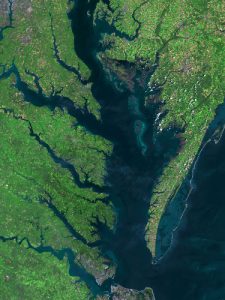
The largest estuary in North America, the Chesapeake Bay is a major source of seafood. Important fisheries include Atlantic blue crabs, oysters, clams, and several species of finfish.
Blue crabs are an important species throughout the bay. They are harvested from the upper bay to the estuary’s merger with the Atlantic Ocean, using a variety of gear.
Maryland and Virginia measure the Bay’s blue crab population through an annual winter dredge survey. Dredge survey data is used by the Chesapeake Bay Stock Assessment Committee (CBSAC) when compiling the Committee’s Blue Crab Advisory Report.
Oysters have a tumultuous history in the Chesapeake Bay. Early explorers of the estuary found unimaginable numbers of oysters and other shellfish. As colonial settlements expanded along the bay, a commercial oyster industry developed, eventually reaching unsustainable levels.
In the 1900’s diseases and other factors led to a crash in oyster populations that nearly destroyed the industry. In recent years, oyster populations have rebounded in the Chesapeake Bay, bringing a much-needed renewal to the oystering industry.
Commercial harvesting of clams is viable in some parts of the bay. Quahogs are harvested using patent tong rigs. Soft-shelled clams and razor clams are harvested using mechanized diggers.
Finfish are also important for Chesapeake Bay watermen, especially striped bass, white perch, croaker, spot, drum, seatrout, flounder, and menhaden.
Related Information